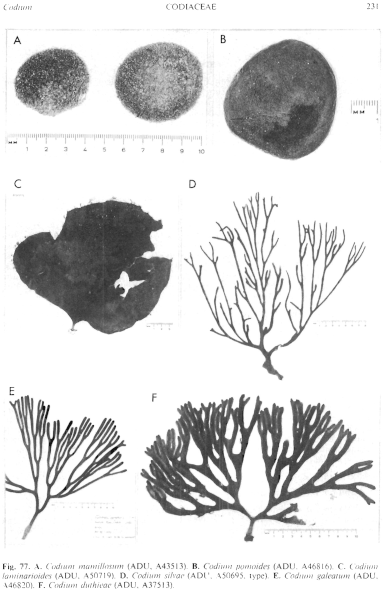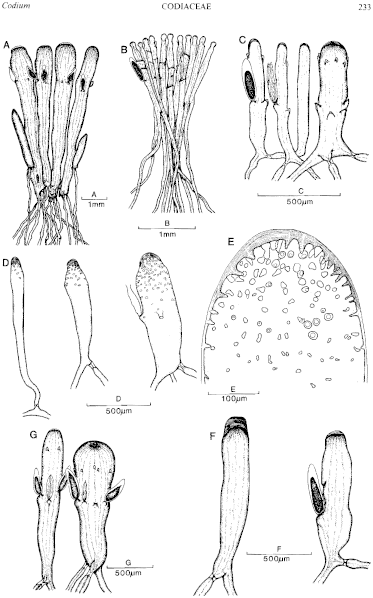|
|
|
|
|
|||||||||||
|
Electronic Flora of South Australia Species Fact Sheet
Phylum Chlorophyta – Order Codiales – Family Codiaceae
Thallus (Fig. 77F) light to medium green, erect, subdichotomously to laterally branched, to 60 cm high, with branches terete and 3–10 mm in diameter but usually compressed (to 2 cm broad) at and near points of branching, branches moderately soft. Utricles (Fig. 78G) cylindrical to clavate, (130–) 1 75–500 (–700) µm in diameter near apices, (450–) 650–1800 (–2500) µm long; apices broadly rounded, wall usually remaining thin, occasionally slightly thickened; hairs (or scars) occasional to numerous. Medullary filaments usually 40–75 µm in diameter, with plugs usually adjacent to utricle base. Gametangia elongate-ovoid, usually tapering above, 70–160 µm in diameter, (230–) 270–430 µm long, several per utricle and borne on a short protuberance from utricle.
Type from Strandfontein, South Africa; in UC, 920260.
Selected specimens: Safety Bay, W. Aust., drift (Womersley, 29.ix.1979; ADU, A50742). Pearson I., S. Aust., 20–25 m deep (Shepherd, 7.i.1 969; ADU, A33651). Elliston, S. Aust., upper sublittoral (Womersley, 15.i.1951; ADU, A13624) and 4 m deep (Shepherd, 22.x.1970; ADU, A37513). Port MacDonnell, S. Aust., drift (Womersley, 15.v.1982; ADU, A53153-"Marine Algae of southern Australia" No. 229). Muston, American R. inlet, Kangaroo I., S. Aust., 2–3 m deep (Womersley, 21.xi.1968; ADU, A32936). Walkerville, Vic., drift (Sinkora A2318, 7.iii.1976; ADU, A48355). East Cove, Deal I., Bass Str., 15 m deep (Shepherd & Lewis, 5.v.1974; ADU, A45253).
Distribution: From Champion Bay, W. Aust. to Walkerville, Vic. and the north coast of Tasmania.
Taxonomic notes: South Africa, from Saldanha Bay to Limpopo River mouth, Mozambique.
C. duthieae is usually found on coasts of slight to moderate water movement but occasionally on rough-water coasts, from low tide level to 25 metres deep. It is characterised by its form, flattening near the points of branching, and by the relatively large, often clavate, utricles usually with thin apical walls.
References:
SILVA, P.C. & WOMERSLEY, H.B.S. (1956). The genus Codium (Chlorophyta) in southern Australia. Aust. J. Bot. 4, 261–289.
The Marine Benthic Flora of Southern Australia Part I complete list of references.
Publication:
Womersley, H.B.S. (31 May, 1984)
The Marine Benthic Flora of Southern Australia
Part I
©Board of the Botanic Gardens and State Herbarium, Government of South Australia
Illustrations in Womersley Part I, 1984: FIGS 77F, 78G.

Figure 77 enlarge
Fig. 77. A. Codium mamillosum (ADU, A43513). B. Codium pomoides (ADU, A46816). C. Codium laminarioides (ADU, A50719). D. Codium silvae (ADU, A50695, type). E. Codium galeatum (ADU, A46820). F. Codium duthieae (ADU, A37513).

Figure 78 enlarge
Fig. 78. Utricle clusters with gametangia. A. Codium mamillosum (Royce 1200, in PERTH, UC). B. Codium pomoides (Cribb 75.16 in UC). C. Codium laminarioides (Cribb 61.42 in UC). D. Codium silvae (ADU, A50695, type). E. Codium silvae, apex of utricle. F. Codium galeatum (lectotype left and Royce 1196 right). G. Codium duthieae (ADU, A13624). (After Silva & Womersley 1956.)

|
Email Contact: State Herbarium of South Australia |

|